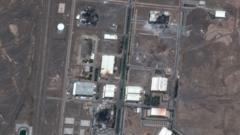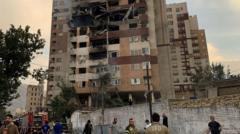Concerns mount as both nations exchange accusations amid rising tensions in the region.
**Escalating Tensions: No Significant Damage to Iran's Nuclear Facilities, Reports IAEA**

**Escalating Tensions: No Significant Damage to Iran's Nuclear Facilities, Reports IAEA**
The International Atomic Energy Agency confirms limited damage due to Israeli strikes on Iran's nuclear sites.
The head of the International Atomic Energy Agency (IAEA), Rafael Grossi, has reported that recent Israeli attacks on Iran's nuclear facilities have not resulted in significant additional damage beyond what was previously documented. Speaking at a meeting of member states in Vienna, Grossi indicated that while an above-ground enrichment facility at Natanz suffered destruction, the underground components remained intact. The incident involved the destruction of several structures at Isfahan, including a uranium conversion plant, yet no evidence was found indicating damage to the underground Fordo enrichment facility.
Following the strikes, Israel claimed the operations were necessary to inhibit Iran's advancement in nuclear weapon capabilities, alleging that nine nuclear scientists were killed in the process. With Iran insisting its nuclear program is strictly for peaceful purposes, officials from Tehran have called for a robust reaction from the IAEA against the Israeli assaults.
Despite the claims of damage from both parties, Grossi emphasized that radiation levels around the affected sites have not exceeded normal ranges, suggesting that immediate radiological risks are minimal. He did, however, express concern over the loss of power to centrifuges at Natanz, as this could hinder operations.
Iran has countered Israel's assertions with its own claims of limited damage at Fordo and ongoing missile retaliations against Israel, attributing the attacks to their defense against what they term “aggression.” The cycle of violence has resulted in significant civilian casualties, with Iranian health officials reporting over 220 deaths due to the strikes and a rising toll on the Israeli side as well.
The backdrop of these exchanges is rooted in the ongoing fallout from the 2015 nuclear deal, which the United States abandoned in 2018. Since then, tensions have only escalated, with Iran's enriched uranium levels significantly exceeding the limits established by the agreement. As both nations threaten further military actions, experts warn of the rising stakes and potential for a deeper conflict in the region.
Following the strikes, Israel claimed the operations were necessary to inhibit Iran's advancement in nuclear weapon capabilities, alleging that nine nuclear scientists were killed in the process. With Iran insisting its nuclear program is strictly for peaceful purposes, officials from Tehran have called for a robust reaction from the IAEA against the Israeli assaults.
Despite the claims of damage from both parties, Grossi emphasized that radiation levels around the affected sites have not exceeded normal ranges, suggesting that immediate radiological risks are minimal. He did, however, express concern over the loss of power to centrifuges at Natanz, as this could hinder operations.
Iran has countered Israel's assertions with its own claims of limited damage at Fordo and ongoing missile retaliations against Israel, attributing the attacks to their defense against what they term “aggression.” The cycle of violence has resulted in significant civilian casualties, with Iranian health officials reporting over 220 deaths due to the strikes and a rising toll on the Israeli side as well.
The backdrop of these exchanges is rooted in the ongoing fallout from the 2015 nuclear deal, which the United States abandoned in 2018. Since then, tensions have only escalated, with Iran's enriched uranium levels significantly exceeding the limits established by the agreement. As both nations threaten further military actions, experts warn of the rising stakes and potential for a deeper conflict in the region.























